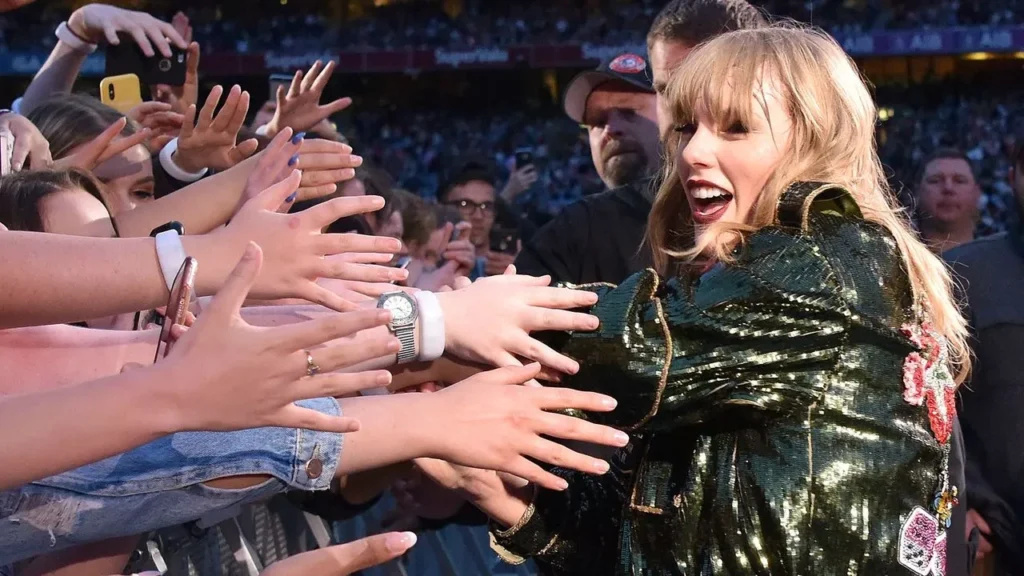By 2025, attending a concert is no longer just about stadiums, long lineups, and nosebleed seats.. With the rise of high-resolution virtual reality (VR) and spatial audio, virtual concerts are now a mainstream entertainment option—and leading the charge is none other than Taylor Swift.
Her 2025 world tour includes an immersive, full-scale VR concert experience that’s being hailed as a cultural and technological milestone. Fans from all over the world can now see a Taylor Swift performance from the comfort of their own bedrooms using VR goggles. This change aims to redefine live music in the digital era, not merely for convenience.
📱 From Stadiums to Headsets: A New Era in Live Music
After COVID-19 changed the live entertainment landscape in the early 2020s, artists experimented with livestreamed performances, AR filters, and social media concerts. But in 2025, VR technology has matured. Companies like Meta, Apple, and Sony now offer affordable, high-resolution VR headsets with lifelike haptic feedback and ultra-low latency.
Always on the cutting edge, Taylor Swift collaborated with major streaming services and VR company Aurora Live to introduce TS | VR Experience, a digital version of her Eras Tour that was recorded.using volumetric cameras and spatial audio, rendered in real time for global audiences.
With just a headset and an internet connection, fans can:
- Stand in a 360° immersive crowd
- Get front-row views or bird’s-eye perspectives
- Hear dynamic sound that shifts as they move
- Watch exclusive behind-the-scenes content
- Even interact with other fans as avatars
👑 Taylor Swift: Reinventing the Concert Economy
Taylor’s decision to bring her tour to VR wasn’t just artistic—it was also revolutionary from a business standpoint. Her VR concerts:
- Sell for $29.99–$59.99 per ticket
- Include merch integration with virtual items and NFTs
- Offer replay windows for fans who miss the live stream
- Feature VR-exclusive encores and behind-the-scenes footage
Within the first week, the virtual version of her opening night grossed over $100 million globally, rivaling in-person attendance numbers. The tour’s digital reach is now more than 10 times larger than her physical venues combined.

🌐 Global Access Without Borders
In places where Swift might never tour physically—rural towns, politically restricted countries, or regions without major arenas—fans now get the full concert experience without compromise. The platform offers:
- Multi-language interfaces
- Adaptive streaming for lower internet bandwidths
- Subtitles and ASL avatar support
As one fan from Brazil put it: “This was my first Taylor concert ever. And I danced like I was front row.”
🎧 The Technology Behind the Magic
The virtual concert experience is powered by:
- Volumetric video capture: 360° rendering of Taylor and her dancers in motion
- Spatial audio processing: Surround-sound feel that changes as you move
- Motion tracking: Fans’ avatars clap, sway, and cheer in real time
- Ultra-realistic stage design: Digitally re-created stages using game engine tech (like Unreal Engine 5)
Fans can pick between being in a crowded stadium or on a private floating platform in space thanks to artificial intelligence (AI) used by Aurora Live, the company that is hosting the show.
🕹️ Interaction Meets Fandom
Unlike traditional concert films, VR shows offer interactive features:
- Fans can cheer, wave, and dance as avatars
- Swift-themed virtual meetups happen before and after shows
- Merch booths allow fans to buy limited-edition digital items
- Gamified achievements (e.g., “Most Cheers Given” or “Best Dance Moves”) earn fans badges and unlockables
The platform even hosts “Swiftie Watch Parties”, where groups can attend together and talk live.
🌟 What This Means for the Music Industry
Taylor Swift is just the beginning. Other artists like BTS, Billie Eilish, and Bad Bunny are announcing VR tour dates following Swift’s success. Live Nation, Spotify, and Apple Music are all developing VR arms, seeing this as a new frontier of global access, sustainability, and creative expression.
Labels, too, are investing in virtual stage design, avatar performance licensing, and immersive storytelling, transforming the traditional concert tour model.
🎵 Critics and Challenges
Not everyone is thrilled. Some critics argue:
- VR cannot replicate the unadulterated enthusiasm of an in-person audience.
- Accessibility is still limited for those without headsets
- The intimacy of small venues may be lost in digital scale
Still, even skeptics agree that VR is not a replacement—it’s an expansion. For fans unable to attend live, this is the closest thing to being there.
🔮 Future Possibilities
With advancements in haptic suits, scent technology, and real-time motion AI, the future of concerts might become even more immersive:
- Feel the bass vibrate in your chest
- Smell the fog machine or concession popcorn
- Shake hands with a virtual Taylor avatar
FAQs: Taylor Swift’s Virtual Concert in VR (2025)
1. How do I attend the Taylor Swift VR concert?
You need a compatible VR headset (like Meta Quest, Apple Vision Pro, or Sony XR) and access to the Aurora Live platform. Tickets can be purchased through their website or app.
2. How much does it cost?
Ticket prices range from $29.99 for standard access to $59.99 for premium tiers, which include extra content, virtual merch, and extended viewing windows.
3. Can I watch without a VR headset?
Yes. A 2D version is available on select streaming platforms, but it lacks the full immersive experience.
4. What happens if I miss the live show?
Replays are available for up to 72 hours after the live show, depending on your ticket tier.
5. Is it interactive? Can I see other fans?
Yes! You can choose to attend as a solo viewer or in a social mode where you see and interact with other fans’ avatars—cheering, dancing, and chatting in real time.






